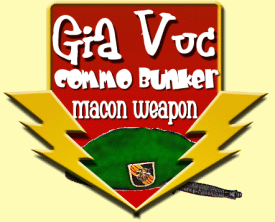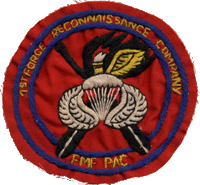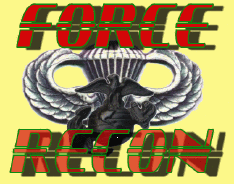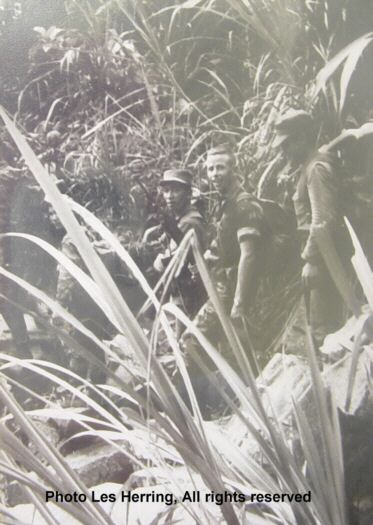|

The Gia Vuc Commo bunker
display in 2007 also included a US Marines mannequin.
You may ask why? After all not many Marines
where found in A-camps in South
Vietnam!
These were Marines from
Force Recon, Sub Unit 1,
First Force Reconnaissance Co
In
1965, only two active Force Reconnaissance
Company existed, The 1st Force Recon,
1st Marine Division part of the Fleet
Marine Force, Pacific: FMF PAC and the 2nd
Force Recon Company, 2nd Marine
Division part of the FMF LANT (Atlantic Fleet).
The 3rd Marine Division based at Okinawa did not
have an active Force Recon and was reinforced by
the 1ST Marine Division through a Sub
Unit (subordinate unit). SubUnit 1 was on a
Platoon rotating cycle of approx 12 months. Sub
Unit 1, 1st Platoon was the first Force Recon
unit to serve in South
Vietnam and was
lead by Cpt David Whittingham . There first
mission in Vietnam after their arrival in November 1964 was the reconnaissance of the area
around CAM RAHN BAY for its
selection as major port for the US forces in
Vietnam , they
also carried out reconnaissance and survey of
the beaches around Da Nang prior to
the Marine Battalion landing.
By
May 1965
2nd Platoon had joined 1st
Platoon in Vietnam and its members were assigned
to US Special
Forces A-camps
in the I Corps with a twofold mission :
a) gaining experience
in the mountain approaches to the Marine
tactical area of operation
along the Laos border
b)
to forward
intelligence
directly to the III
Marine Amphibious
Force.

"Current Vietnam made
Repro patch in my collection"
|

Force Recon
Sub Unit Number 1,
First Force
Reconnaissance Company
At
full strength a Vietnam Force Recon
Platoons consisted of 16 Marines,
1 officer, 1 senior NCO, 1
parachute rigger,
1 dive NCO and 3 reconnaissance
teams of 4 Marines each.
Their primary missions were to conduct:
A)
Pre-assault reconnaissance
for
amphibious landing forces which
included hydro graphic surveys of proposed landing sites as well as
beach exits, inland cross-country
trafficability and engineering data.
B)
Deep reconnaissance into
hostile territory
to report on enemy locations, routes
of communication, strength,
equipment, etc.
Their secondary missions usually
included direct action activities
such as combat patrols, search &
destroy demolition and combine
operations with other units.
To
give you an idea of the
effectiveness of Force Recon, please
read some facts and figures from
Maj James Steele, Intelligence
Section, Senior Marine headquarters,
South
Vietnam,
1967
Kill
ratio for Marine battalion was 7.6
enemies to one Marine
Kill ratio for Force Recon was 34
enemies for each of their own
Marine
infantry required approx 7 ton of
equipment to produce a body count
Force Recon required 2 ton for the
same result
In
an infantry unit 80% of the contacts
were initiated by the enemy
Only 5% of Force Recon contacts
were initiated by the enemy.
Cpl Les Herring Team
leader,
1st Platoon, Sub Unit 1,
1st
Force Recon Co,
Gia Vuc May-July 1965
“My platoon, Sub Unit 1 arrived in Okinawa in November 1964 and conducted training operations
until December 1964 when we boarded a small destroyer
specifically designed to carry Marine Recon and Navy
UDT/SEAL teams to areas of operation. After spending
Christmas day in Subic Bay , in the Philippines we sailed to southern Thailand to conduct recon patrols. Each of our 4 man
teams had 1 Thai Marine attached as interpreter. After
completing those operations we arrived in Vietnam and began conducting operations for the planned Marine
amphibious landings that would begin in March 1965. We
began attachments to SF A-Teams in May 1965 for a
couple of months and conducted recon and combat
patrols in the I Corps. Members of
1st and second platoon were attached
to Gia Vuc in Mai 1965”
|
|
LCpl
Ray Rossi Radio Operator,
2nd Platoon, Sub
Unit 1,
1st Force Recon Co,
Gia Vuc May-July 1965
What I had become aware of almost
overnight was just how special these Special Forces
A-Team troops really are…since we were
fledgling young newcomers, we cherished every lesson
learned. These A-teams consisted of 10-12 highly
trained Special Forces Green Berets. The sergeant in
charge of the Gia-Vuc's armory looked at our outdated
M-3 A 1 grease guns and immediately marched us over to
inspect the arsenal of weapons they had…every kind
of military weapon and then some: shotguns, carbines,
pistols, rifles…even an M-1 sniper rifle, (which I
had the privilege of carrying on two patrols.) We had
our choice of any of these weapons to use on upcoming
missions. It
was at Gia Vuc that the Special Forces troops
outfitted us with black pyjamas for casual wear around
the camp at night and morning. They also gave us the
ranger style web gear (M57) and plastic canteens, the Tiger Stripe uniforms and jungle boots. Back
in 1965, we were allowed to wear a variety of
uniforms. I did wear a set of the Camo's from the era
of the Marine Raiders of WWII but they were extremely
hot so they were best suited for the monsoon season.
In camp the dress code was fairly casual as I
remember. Many times we simply wore the standard
fatigue type trousers with OD T/shirt and jungle boots
with Marine Corps cover. We did not wear side arm but
generally always carried our weapon wherever we went.
|


SFC B Gifford &
Sgt. H P Vialpando,
USMC

Photos taken during a
patrol around Gia Vuc
|
(left) Detail photos taken
with flash (right)
|


Force Recon NCO in Commo
Bunker

Detail of display board
on Gia Vuc,
Bunker &
Force Recon
|
|

|
|